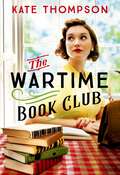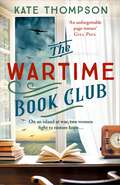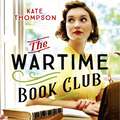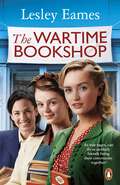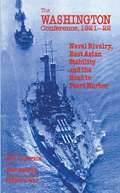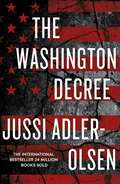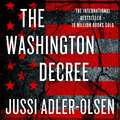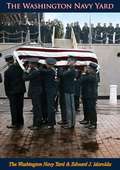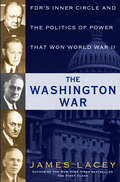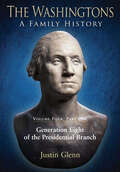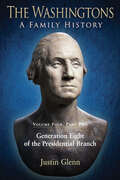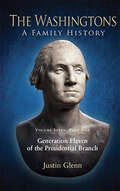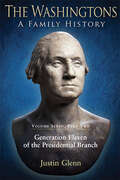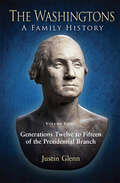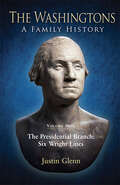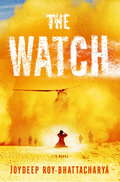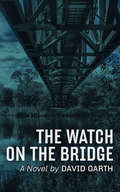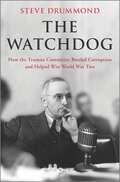- Table View
- List View
The Wartime Book Club
by Kate ThompsonInspired by true events, The Wartime Book Club is an unforgettable story of everyday bravery and resistance, full of romance, drama, and camaraderie and a tribute to the joy of reading and the power of books in our darkest hour. The Isle of Jersey was once a warm and neighborly community, but in 1943, German soldiers patrol the cobbled streets, imposing a harsh rule. Nazis have ordered Grace La Mottée, the island's only librarian, to destroy books that threaten the new regime. Instead, she hides the stories away in secret. Along with her headstrong best friend, she wants to fight back. So she forms the Wartime Book Club: a lifeline, offering fearful islanders the joy and escapism of reading. But as the occupation drags on, the women's quiet acts of bravery become more perilous – and more important – than ever before. And when tensions turn to violence, they are forced to face the true, terrible cost of resistance . . . Based on astonishing real events, The Wartime Book Club is a love letter to the power of books in the darkest of times – as well as a moving page-turner that brings to life the remarkable, untold story of an island at war.
The Wartime Book Club: a gripping and heart-warming new story of love, bravery and resistance in WW2, inspired by a true story
by Kate Thompson*BASED ON A TRUE STORY, CONTAINS 50+ PAGES OF EXTRA CONTENT ON THE REAL PEOPLE THE BOOK IS INSPIRED BY*Jersey, 1943. When the German Army invades the tranquil island, librarian Grace La Motée is determined to keep her services running. Ordered to destroy books which threaten the Nazi regime, she refuses, instead hiding them away and fighting back by forming a book club: a lifeline to help islanders escape the terror of war, one chapter at a time.But soon Grace's quiet acts of bravery become even more perilous. She's harbouring dangerous secrets - ones that put her life in danger - and when tensions turn to violence, she is forced to face the true, terrible cost of resistance . . .Based on astonishing real events, The Wartime Book Club is a love letter to the power of books in the darkest of times - as well as a moving page-turner that brings to life the remarkable, untold story of an island at war.EVERYONE LOVES THE WARTIME BOOK CLUB:'Wish I could give it more stars' ⭐⭐⭐⭐⭐'I was utterly enthralled . . . it reminds us how strong we can be in the face of adversity' ⭐⭐⭐⭐⭐'Tears, laughs and genuine love for all the characters in this book' ⭐⭐⭐⭐⭐'A heartwarming tale . . . shows against all odds and hardships people can survive' ⭐⭐⭐⭐⭐'Full of wonderful characters and their determination to get through the worst times' ⭐⭐⭐⭐⭐AND SO DO YOUR FAVOURITE AUTHORS...'One of the very best books I've read in a long time' PETER JAMES'Engaging' RACHEL HORE'Both heartwarming and heartbreaking' GILL PAUL'A poignant masterpiece' MADELINE MARTIN'A book to be savoured and remembered' GILL THOMPSON
The Wartime Book Club: the heart-warming and inspiring new novel of love, bravery and resistance in WW2
by Kate ThompsonA gripping and heartwarming novel inspired by the true events of the women who joined the resistance in Jersey during the German occupation in WW2.From enchanting cliff tops and white sandy bays to the pretty cobbled streets of St Helier, Jersey is known as the land of milk and honey. But for best friends Bea Rose (the local postwoman) and Grace Le Motte (who works in the island's only library) it becomes the frontline to everyday resistance when their beloved island is occupied by German forces in 1940.Inspired by astonishing true events, THE WARTIME BOOK CLUB is an unforgettable story of everyday bravery and resistance, full of romance, drama and camaraderie and a tribute to the joy of reading and the power of books in our darkest hour.(P)2024 Hodder & Stoughton Limited
The Wartime Bookshop: The first in a heart-warming WWII saga series about community and friendship, from the bestselling author (The Wartime Bookshop #1)
by Lesley EamesThe first in a brand-new nostalgic and heart-warming WWII series, perfect for fans of Donna Douglas and Elaine Everest.Alice is nursing an injured hand and a broken heart when she moves to the village of Churchwood at the start of WWII. She is desperate to be independent but worries that her injuries will make that impossible.Kate lives with her family on Brimbles Farm, where her father and brothers treat her no better than a servant. With no mother or sisters, and shunned by the locals, Kate longs for a friend of her own.Naomi is looked up to for owning the best house in the village. But privately, she carries the hurts of childlessness, a husband who has little time for her and some deep-rooted insecurities.With war raging overseas, and difficulties to overcome at home, friendship is needed now more than ever. Can the war effort and a shared love of books bring these women - and the community of Churchwood - together?**The fifth novel, A Foundling at the Wartime Bookshop, is available to buy now!**-------------------------------**Real readers are LOVING The Wartime Bookshop**'BRILLIANT''Oh I loved this book... please carry on the good writing''Wow what a brilliant start to a new series''Outstandingly fabulous, warm and inviting... so glad there is going to be a follow-on''I was only two pages in when I knew this would be a 5 star read... I honestly can't put my excitement into words at the thought of reading the next one'
The Washington Conference, 1921-22: Naval Rivalry, East Asian Stability and the Road to Pearl Harbor
by Erik Goldstein John MaurerThe Washington Conference regulated the inter-war naval race between the world powers. In the era when it was still believed that battleships were the epitome of naval power and a sign of a country's strength, this conference led to limitations on the building of such weapons by the naval powers of Britain, the USA and Japan. This collection of essays deals with many aspects of the conference; the factors that caused it, the interests of the participating nations both present and future, and the results.
The Washington Decree
by Jussi Adler-OlsenThe New York Times and #1 internationally bestselling author of the Department Q series is back, with a terrifyingly relevant stand-alone novel about an America in chaos. THE NO. 1 INTERNATIONAL BESTSELLING AUTHOR24 MILLION BOOKS SOLDWINNER OF THE GLASS KEY AWARD"The president has gone way too far. . . . These are practically dictatorial methods we're talking about." When Democratic Senator Bruce Jansen is elected president of the United States, it is a personal victory for Dorothy "Dottie" Rogers. She has secured a job in the White House, has proved to her Republican father that she was right to support Jansen, and is proud to see the rise of an intelligent, inspiring leader who shares her ideals. But the triumph is short-lived: Jansen's pregnant wife is assassinated on election night, and the alleged mastermind behind the shooting is none other than Dottie's own father. When Jansen ascends to the White House, he is a changed man, determined to end gun violence by any means necessary. Rights are taken away as quickly as weapons. Checkpoints and roadblocks destroy infrastructure. The media is censored. Militias declare civil war on the government. The country is in chaos, and Dottie's finds herself fighting for the life of her father, who just may be innocent.
The Washington Decree
by Jussi Adler-OlsenThe New York Times and #1 internationally bestselling author of the Department Q series is back, with a terrifyingly relevant stand-alone novel about an America in chaos. THE NO. 1 INTERNATIONAL BESTSELLING AUTHOR24 MILLION BOOKS SOLDWINNER OF THE GLASS KEY AWARD"The president has gone way too far. . . . These are practically dictatorial methods we're talking about." When Democratic Senator Bruce Jansen is elected president of the United States, it is a personal victory for Dorothy "Dottie" Rogers. She has secured a job in the White House, has proved to her Republican father that she was right to support Jansen, and is proud to see the rise of an intelligent, inspiring leader who shares her ideals. But the triumph is short-lived: Jansen's pregnant wife is assassinated on election night, and the alleged mastermind behind the shooting is none other than Dottie's own father. When Jansen ascends to the White House, he is a changed man, determined to end gun violence by any means necessary. Rights are taken away as quickly as weapons. Checkpoints and roadblocks destroy infrastructure. The media is censored. Militias declare civil war on the government. The country is in chaos, and Dottie's finds herself fighting for the life of her father, who just may be innocent.
The Washington Navy Yard
by Edward J. Marolda The Washington Navy YardDuring much of the 19th and 20th centuries, the Washington Navy Yard was the most recognizable symbol of the United States Navy in the nation’s capital. The shipyard built a number of the Navy’s first warships and repaired, refitted, and provisioned most of the frigates, sloops, and other combatants of the fledgling naval service. The masts and rigging of USS Constitution were a common site on the banks of the Anacostia River. Booming cannon became a routine sound in southeast Washington during the mid-19th century as Commander John A. Dahlgren, “father of American naval ordnance,” test-fired new guns for the fleet. The Naval Gun Factory’s fire and smoke-belching blast furnaces, foundries, and mills gave birth to many of the fleet’s weapons, from small boat howitzers to the enormous 14-inch and 16-inch rifles that armed the naval railway batteries in World War I and the Iowa-class battleships in World War II and the Cold War. Rear-Admiral David W. Taylor inaugurated a new era in ship development when he used scientific measurements in his Experimental Model Basin to test the properties of prototype hulls. Before and after World War I, the pioneers of naval aviation experimented in the Anacostia and navy yard facilities with various seaplane types, shipboard catapults, and other equipment that would soon revolutionize warfare at sea.
The Washington War: FDR's Inner Circle and the Politics of Power That Won World War II
by James LaceyA Team of Rivals for World War II—the inside story of how FDR and the towering personalities around him waged war in the corridors of Washington, D.C., to secure ultimate victory on the battlefields of Europe and the Pacific. The Washington War is the story of how the Second World War was fought and won in the capital’s halls of power—and how the United States, which in December 1941 had a nominal army and a decimated naval fleet, was able in only thirty months to fling huge forces onto the European continent and shortly thereafter shatter Imperial Japan’s Pacific strongholds. Three quarters of a century after the overwhelming defeat of the totalitarian Axis forces, the terrifying, razor-thin calculus on which so many critical decisions turned has been forgotten—but had any of these debates gone the other way, the outcome of the war could have been far different: The army in August 1941, about to be disbanded, saved by a single vote. Production plans that would have delayed adequate war matériel for years after Pearl Harbor, circumvented by one uncompromising man’s courage and drive. The delicate ballet that precluded a separate peace between Stalin and Hitler. The almost-adopted strategy to stage D-Day at a fatally different time and place. It was all a breathtakingly close-run thing, again and again. Renowned historian James Lacey takes readers behind the scenes in the cabinet rooms, the Pentagon, the Oval Office, and Hyde Park, and at the pivotal conferences—Campobello Island, Casablanca, Tehran—as these disputes raged. Here are colorful portraits of the great figures—and forgotten geniuses—of the day: New Dealers versus industrialists, political power brokers versus the generals, Churchill and the British high command versus the U.S. chiefs of staff, innovators versus entrenched bureaucrats . . . with the master manipulator, Franklin Delano Roosevelt, at the center, setting his brawling patriots one against the other and promoting and capitalizing on the furious turf wars. Based on years of research and extensive, previously untapped archival resources, The Washington War is the first integrated, comprehensive chronicle of how all these elements—and towering personalities—clashed and ultimately coalesced at each vital turning point, the definitive account of Washington at real war and the titanic political and bureaucratic infighting that miraculously led to final victory.
The Washingtons. Volume 1: Seven Generations of the Presidential Branch (The Washingtons: A Family History #1)
by Justin GlennThis is the initial volume of a comprehensive history that traces the “Presidential line” of the Washingtons. Volume one begins with the immigrant John Washington who settled in Westmoreland Co., Va., in 1657, married Anne Pope, and was the great-grandfather of President George Washington. This volume continues the story of John and Anne’s family for a total of seven generations, collecting over 5,000 direct descendants. Future volumes will trace eight more generations with a total of over 63,000 descendants. Although structured in a genealogical format for the sake of clarity, this is no bare bones genealogy but a true family history with over 1,200 detailed biographical narratives. These in turn strive to convey the greatness of the family that produced not only The Father of His Country but many others, great and humble, who struggled to build that country. The Washingtons includes the time-honored John Wright line which in recent years has been challenged largely on the basis of DNA evidence. Volumes one and two will form a set, with a cumulative bibliography appearing at the end of volume 2. Volume two will highlight the most notable descendants and spouses from the later volumes, including such luminaries as General George S. Patton, the author Shelby Foote, and the actor Lee Marvin. All of the volumes, now estimated at fourteen in all, are virtually complete and are scheduled for release over the course of the next year.
The Washingtons. Volume 2: Notable Members of the Presidential Branch (The Washingtons: A Family History #2)
by Justin GlennThis is the second volume of a comprehensive history that traces the “Presidential line” of the Washingtons. Volume one began with the immigrant John Washington who settled in Westmoreland Co., Va., in 1657, married Anne Pope, and was the great-grandfather of President George Washington. It continued the record of their descendants for a total of seven generations. Volume two is a collection of notable descendants of the next eight generations of John and Anne Washington’s descendants, including such luminaries as General George S. Patton, the author Shelby Foote, and the actor Lee Marvin. Future volumes will trace generations eight through fifteen, making a total of over 63,000 descendants. Although structured in a genealogical format for the sake of clarity, this is no bare bones genealogy but a true family history with over 1,200 detailed biographical narratives. These in turn strive to convey the greatness of the family that produced not only The Father of His Country but many others, great and humble, who struggled to build that country. The Washingtons includes the time-honored John Wright line which in recent years has been challenged largely on the basis of DNA evidence. Volumes one and two form a set, with a cumulative bibliography appearing at the end of volume two.
The Washingtons. Volume 3: Royal Descents of the Presidential Branch (The Washingtons: A Family History #3)
by Justin GlennThis Royal Descents supplement is an outgrowth of the author’s multi-volume family history of the “Presidential Branch” of the Washingtons. That work collects the descendants of the immigrant John Washington who settled in Westmoreland Co., Va., in 1657, married Anne Pope, and became the great-grandfather of President George Washington. The Royal Descents traces the ancestry of the early Virginia members of this “Presidential Branch” back in time to the aristocracy and nobility of England and continental Europe, including the Plantagenet dynasty, William the Conqueror, Alfred the Great, Charles Martel, and Charlemagne. ADVANCE PRAISE for The Washingtons: A Family History “I am convinced that your work will be of wide interest to historians and academics as well as members of the Washington family itself. Although the surname Washington is perhaps the best known in American history and much has been written about the Washington family for well over a century, it is surprising that no comprehensive family history has been published. Justin M. Glenn’s The Washingtons: A Family History finally fills this void for the branch to which General and President George Washington belonged, identifying some 63,000 descendants. This is truly a family history, not a mere tabulation of names and dates, providing biographical accounts of many of the descendants of John Washington who settled in Westmoreland County, Virginia, in 1657. . . . Each individual section is followed by extensive listings of published and manuscript sources supporting the information presented and errors of identification in previous publications are commented upon as appropriate.” John Frederick Dorman, editor of The Virginia Genealogist (1957-2006) and author of Adventurers of Purse and Person “Decades of reviewing Civil War books have left me surprised and delighted when someone applies exhaustive diligence to a topic not readily accessible. Dr. Glenn surely meets that standard with the meticulous research that unveils the Washington family in gratifying detail—many of them Confederates of interest and importance.” Robert K. Krick, author of The Smoothbore Volley that Doomed the Confederacy and Stonewall Jackson at Cedar Mountain
The Washingtons. Volume 4, Part 1: Generation Eight of the Presidential Branch (The Washingtons: A Family History #4.2)
by Justin GlennThis is the fourth volume of Dr. Justin Glenn’s comprehensive history that traces the “Presidential line” of the Washingtons. Volume One began with the immigrant John Washington, who settled in Westmoreland Co., Va., in 1657, married Anne Pope, and became the great-grandfather of President George Washington. It continued the record of their descendants for a total of seven generations. Volume Two highlighted notable members of the next eight generations of John and Anne Washington’s descendants, including General George S. Patton, author Shelby Foote, and actor Lee Marvin. Volume Three traced the ancestry of the early Virginia members of this “Presidential Branch” back in time to the aristocracy and nobility of England and continental Europe. Volume Four resumes the family history where Volume One ended. It presents Generation Eight of the immigrant John Washington’s descendants, containing nearly 7,000 descendants. Future volumes will trace generations nine through fifteen, making a total of over 63,000 descendants. Although structured in a genealogical format for the sake of clarity, this is no bare bones genealogy but a true family history with over 1,200 detailed biographical narratives. These in turn strive to convey the greatness of the family that produced not only The Father of His Country but many others, great and humble, who struggled to build that country. Volume Four, Part One covers the descendants of the immigrant John Washington’s child Lawrence Washington. Volume Four, Part Two covers the descendants of the Immigrant’s children John Washington, Jr., and Anne (Washington) Wright.
The Washingtons. Volume 4, Part 2: Generation Eight of the Presidential Branch (The Washingtons: A Family History #4.2)
by Justin GlennThis is the fourth volume of Dr. Justin Glenn’s comprehensive history that traces the “Presidential line” of the Washingtons. Volume One began with the immigrant John Washington, who settled in Westmoreland Co., Va., in 1657, married Anne Pope, and became the great-grandfather of President George Washington. It continued the record of their descendants for a total of seven generations. Volume Two highlighted notable members of the next eight generations of John and Anne Washington’s descendants, including General George S. Patton, author Shelby Foote, and actor Lee Marvin. Volume Three traced the ancestry of the early Virginia members of this “Presidential Branch” back in time to the aristocracy and nobility of England and continental Europe. Volume Four resumes the family history where Volume One ended. It presents Generation Eight of the immigrant John Washington’s descendants, containing nearly 7,000 descendants. Future volumes will trace generations nine through fifteen, making a total of over 63,000 descendants. Although structured in a genealogical format for the sake of clarity, this is no bare bones genealogy but a true family history with over 1,200 detailed biographical narratives. These in turn strive to convey the greatness of the family that produced not only The Father of His Country but many others, great and humble, who struggled to build that country. Volume Four, Part One covers the descendants of the immigrant John Washington’s child Lawrence Washington. Volume Four, Part Two covers the descendants of the Immigrant’s children John Washington, Jr., and Anne (Washington) Wright.
The Washingtons. Volume 5, Part 1: Generation Nine of the Presidential Branch (The Washingtons: A Family History #5.1)
by Justin GlennThis is the fifth volume of Dr. Justin Glenn’s comprehensive history that traces the “Presidential line” of the Washingtons. Volume One began with the immigrant John Washington, who settled in Westmoreland Co., Va., in 1657, married Anne Pope, and became the great-grandfather of President George Washington. It continued the record of their descendants for a total of seven generations. Volume Two highlighted notable family members in the next eight generations of John and Anne Washington’s descendants, including such luminaries as General George S. Patton, the author Shelby Foote, and the actor Lee Marvin. Volume Three traced the ancestry of the early Virginia members of this “Presidential Branch” back in time to the aristocracy and nobility of England and continental Europe. Volume Four resumed the family history where Volume One ended, and it contained Generation Eight of the immigrant John Washington’s descendants. Volume Five now presents Generation Nine, including more than 10,000 descendants. Future volumes will trace generations ten through fifteen, making a total of over 63,000 descendants. Although structured in a genealogical format for the sake of clarity, this is no bare bones genealogy but a true family history with over 1,200 detailed biographical narratives. These in turn strive to convey the greatness of the family that produced not only The Father of His Country but many others, great and humble, who struggled to build that country. ADVANCE PRAISE “I am convinced that your work will be of wide interest to historians and academics as well as members of the Washington family itself. Although the surname Washington is perhaps the best known in American history and much has been written about the Washington family for well over a century, it is surprising that no comprehensive family history has been published. Justin M. Glenn’s The Washingtons: A Family History finally fills this void for the branch to which General and President George Washington belonged, identifying some 63,000 descendants. This is truly a family history, not a mere tabulation of names and dates, providing biographical accounts of many of the descendants of John Washington who settled in Westmoreland County, Virginia, in 1657. . . . Each individual section is followed by extensive listings of published and manuscript sources supporting the information presented and errors of identification in previous publications are commented upon as appropriate.” John Frederick Dorman, editor of The Virginia Genealogist (1957-2006) and author of Adventurers of Purse and Person “Decades of reviewing Civil War books have left me surprised and delighted when someone applies exhaustive diligence to a topic not readily accessible. Dr. Glenn surely meets that standard with the meticulous research that unveils the Washington family in gratifying detail—many of them Confederates of interest and importance.” Robert K. Krick, author of The Smoothbore Volley that Doomed the Confederacy and Stonewall Jackson at Cedar Mountain
The Washingtons. Volume 5, Part 2: Generation Nine of the Presidential Branch (The Washingtons: A Family History #5.1)
by Justin GlennThis is the fifth volume of Dr. Justin Glenn’s comprehensive history that traces the “Presidential line” of the Washingtons. Volume One began with the immigrant John Washington, who settled in Westmoreland Co., Va., in 1657, married Anne Pope, and became the great-grandfather of President George Washington. It continued the record of their descendants for a total of seven generations. Volume Two highlighted notable family members in the next eight generations of John and Anne Washington’s descendants, including such luminaries as General George S. Patton, the author Shelby Foote, and the actor Lee Marvin. Volume Three traced the ancestry of the early Virginia members of this “Presidential Branch” back in time to the aristocracy and nobility of England and continental Europe. Volume Four resumed the family history where Volume One ended, and it contained Generation Eight of the immigrant John Washington’s descendants. Volume Five now presents Generation Nine, including more than 10,000 descendants. Future volumes will trace generations ten through fifteen, making a total of over 63,000 descendants. Although structured in a genealogical format for the sake of clarity, this is no bare bones genealogy but a true family history with over 1,200 detailed biographical narratives. These in turn strive to convey the greatness of the family that produced not only The Father of His Country but many others, great and humble, who struggled to build that country. ADVANCE PRAISE “I am convinced that your work will be of wide interest to historians and academics as well as members of the Washington family itself. Although the surname Washington is perhaps the best known in American history and much has been written about the Washington family for well over a century, it is surprising that no comprehensive family history has been published. Justin M. Glenn’s The Washingtons: A Family History finally fills this void for the branch to which General and President George Washington belonged, identifying some 63,000 descendants. This is truly a family history, not a mere tabulation of names and dates, providing biographical accounts of many of the descendants of John Washington who settled in Westmoreland County, Virginia, in 1657. . . . Each individual section is followed by extensive listings of published and manuscript sources supporting the information presented and errors of identification in previous publications are commented upon as appropriate.” John Frederick Dorman, editor of The Virginia Genealogist (1957-2006) and author of Adventurers of Purse and Person “Decades of reviewing Civil War books have left me surprised and delighted when someone applies exhaustive diligence to a topic not readily accessible. Dr. Glenn surely meets that standard with the meticulous research that unveils the Washington family in gratifying detail—many of them Confederates of interest and importance.” Robert K. Krick, author of The Smoothbore Volley that Doomed the Confederacy and Stonewall Jackson at Cedar Mountain
The Washingtons. Volume 6, Part 1: Generation Ten of the Presidential Branch (The Washingtons: A Family History #6.1)
by Justin GlennThis is the sixth volume of Dr. Justin Glenn’s comprehensive history that traces the “Presidential line” of the Washingtons. Volume One began with the immigrant John Washington, who settled in Westmoreland Co., Va., in 1657, married Anne Pope, and became the great-grandfather of President George Washington. It continued the record of their descendants for a total of seven generations. Volume Two highlighted notable family members in the next eight generations of John and Anne Washington’s descendants. Volume Three traced the ancestry of the early Virginia members of this “Presidential Branch” back to the aristocracy and nobility of England and continental Europe. Volume Four resumed the family history where Volume One ended, and it contained Generation Eight of the immigrant John Washington’s descendants. Volume Five treated Generation Nine. Volume Six now presents Generation Ten, and it includes over 12,000 descendants. Future volumes will add generations eleven through fifteen, making a total of over 63,000 descendants. Although structured in a genealogical format for the sake of clarity, this is no bare bones genealogy but a true family history with over 1,200 detailed biographical narratives. These in turn strive to convey the greatness of the family that produced not only The Father of His Country but many others, great and humble, who struggled to build that country. Volume Six, Part One covers the descendants of the Immigrant John Washington’s children Lawrence Washington and John Washington, Jr. Volume Six, Part Two covers the descendants of the Immigrant’s child Anne (Washington) Wright.
The Washingtons. Volume 6, Part 2: Generation Ten of the Presidential Branch (The Washingtons: A Family History #6.1)
by Justin GlennThis is the sixth volume of Dr. Justin Glenn’s comprehensive history that traces the “Presidential line” of the Washingtons. Volume One began with the immigrant John Washington, who settled in Westmoreland Co., Va., in 1657, married Anne Pope, and became the great-grandfather of President George Washington. It continued the record of their descendants for a total of seven generations. Volume Two highlighted notable family members in the next eight generations of John and Anne Washington’s descendants. Volume Three traced the ancestry of the early Virginia members of this “Presidential Branch” back in time to the aristocracy and nobility of England and continental Europe. Volume Four resumed the family history where Volume One ended, and it contained Generation Eight of the immigrant John Washington’s descendants. Volume Five treated Generation Nine. Volume Six now presents Generation Ten, and it includes over 12,000 descendants. Future volumes will add generations eleven through fifteen, making a total of over 63,000 descendants. Although structured in a genealogical format for the sake of clarity, this is no bare bones genealogy but a true family history with over 1,200 detailed biographical narratives. These in turn strive to convey the greatness of the family that produced not only The Father of His Country but many others, great and humble, who struggled to build that country. ADVANCE PRAISE “I am convinced that your work will be of wide interest to historians and academics as well as members of the Washington family itself. Although the surname Washington is perhaps the best known in American history and much has been written about the Washington family for well over a century, it is surprising that no comprehensive family history has been published. Justin M. Glenn’s The Washingtons: A Family History finally fills this void for the branch to which General and President George Washington belonged, identifying some 63,000 descendants. This is truly a family history, not a mere tabulation of names and dates, providing biographical accounts of many of the descendants of John Washington who settled in Westmoreland County, Virginia, in 1657. . . . Each individual section is followed by extensive listings of published and manuscript sources supporting the information presented and errors of identification in previous publications are commented upon as appropriate.” John Frederick Dorman, editor of The Virginia Genealogist (1957-2006) and author of Adventurers of Purse and Person “Decades of reviewing Civil War books have left me surprised and delighted when someone applies exhaustive diligence to a topic not readily accessible. Dr. Glenn surely meets that standard with the meticulous research that unveils the Washington family in gratifying detail—many of them Confederates of interest and importance.” Robert K. Krick, author of The Smoothbore Volley that Doomed the Confederacy and Stonewall Jackson at Cedar Mountain
The Washingtons. Volume 7, Part 1: Generation Eleven of the Presidential Branch (The Washingtons: A Family History #7.1)
by Justin GlennThis is the seventh volume of Dr. Justin Glenn’s comprehensive history that traces the “Presidential line” of the Washingtons. Volume one began with the immigrant John Washington, who settled in Westmoreland Co., Va., in 1657, married Anne Pope, and became the great-grandfather of President George Washington. It continued the record of their descendants for a total of seven generations. Volume two highlighted notable members of the next eight generations, including such luminaries as General George S. Patton, the author Shelby Foote, and the actor Lee Marvin. Volume three traced the ancestry of the early Virginia members of this “Presidential Branch” back to the royalty and nobility of England and continental Europe. Volumes four, five, and six treated respectively generations eight, nine, and ten. Volume Seven presents generation eleven, comprising more than 10,000 descendants of the immigrant John Washington. Although structured in a genealogical format for the sake of clarity, this is no bare bones genealogy but a true family history with over 1,200 detailed biographical narratives. These strive to convey the greatness of the family that produced not only The Father of His Country but many others, great and humble, who struggled to build that country. Volume Seven, Part One covers the descendants of the immigrant’s children Lawrence and John Washington, Jr. Volume Seven, Part Two covers the descendants of the immigrant’s child Anne (Washington) Wright.
The Washingtons. Volume 7, Part 2: Generation Eleven of the Presidential Branch (The Washingtons: A Family History #7.2)
by Justin GlennThis is the seventh volume of Dr. Justin Glenn’s comprehensive history that traces the “Presidential line” of the Washingtons. Volume one began with the immigrant John Washington, who settled in Westmoreland Co., Va., in 1657, married Anne Pope, and became the great-grandfather of President George Washington. It continued the record of their descendants for a total of seven generations. Volume two highlighted notable members of the next eight generations, including such luminaries as General George S. Patton, the author Shelby Foote, and the actor Lee Marvin. Volume three traced the ancestry of the early Virginia members of this “Presidential Branch” back to the royalty and nobility of England and continental Europe. Volumes four, five, and six treated respectively generations eight, nine, and ten. Volume Seven presents generation eleven, comprising more than 10,000 descendants of the immigrant John Washington. Although structured in a genealogical format for the sake of clarity, this is no bare bones genealogy but a true family history with over 1,200 detailed biographical narratives. These strive to convey the greatness of the family that produced not only The Father of His Country but many others, great and humble, who struggled to build that country. Volume Seven, Part One covers the descendants of the immigrant’s children Lawrence and John Washington, Jr. Volume Seven, Part Two covers the descendants of the immigrant’s child Anne (Washington) Wright.
The Washingtons. Volume 8: Generations Twelve to Fifteen of the Presidential Branch (The Washingtons: A Family History)
by Justin GlennThis is the eighth volume of Dr. Justin Glenn’s comprehensive history that traces the “Presidential line” of the Washingtons. Volume one began with the immigrant John Washington, who settled in Westmoreland Co., Va., in 1657, married Anne Pope, and became the great-grandfather of President George Washington. It continued the record of their descendants for a total of seven generations. Volume two highlighted notable members of the next eight generations, including such luminaries as General George S. Patton, the author Shelby Foote, and the actor Lee Marvin. Volume three traced the ancestry of the early Virginia members of this “Presidential Branch” back to the royalty and nobility of England and continental Europe. Volumes four, five, six, and seven treated respectively generations eight, nine, ten, and eleven. Volume Eight presents generations twelve through fifteen, comprising more than 8,500 descendants of the immigrant John Washington. Although structured in a genealogical format for the sake of clarity, this is no bare bones genealogy but a true family history with over 1,200 detailed biographical narratives. These strive to convey the greatness of the family that produced not only The Father of His Country but many others, great and humble, who struggled to build that country.
The Washingtons. Volume 9: The Presidential Branch: Six Wright Lines (The Washingtons: A Family History #9)
by Justin GlennThis is the ninth volume of a comprehensive history that traces the “Presidential Line” of the Washingtons. Volume one began with the immigrant John Washington who settled in Westmoreland Co., Va., in 1657, married Anne Pope, and was the great-grandfather of President George Washington. It contained the record of their descendants for a total of seven generations. Subsequent volumes two through eight continued this family history for an additional eight generations, highlighting most notable members (volume two) and tracing lines of descent from the royalty and nobility of England and continental Europe (volume three). Volume nine collects over 8,500 descendants of the recently discovered line of William Wright (died in Franklin Co., Va., ca. 1809). It also provides briefer accounts of five other early Wright families of Virginia that have often been mentioned by researchers as close kinsmen of George Washington, including: William Wright (died in Fauquier Co., Va., ca. 1805), Frances Wright and her husband Nimrod Ashby, and William Wright (died in Greensville Co., Va., by 1827). A cumulative index will complete the series as volume ten.
The Watch
by Joydeep Roy-BhattacharyaFollowing a desperate night-long battle, a group of beleaguered soldiers in an isolated base in Kandahar are faced with a lone woman demanding the return of her brother's body. Is she a spy, a black widow, a lunatic, or is she what she claims to be: a grieving young sister intent on burying her brother according to local rites? Single-minded in her mission, she refuses to move from her spot on the field in full view of every soldier in the stark outpost. Her presence quickly proves dangerous as the camp's tense, claustrophobic atmosphere comes to a boil when the men begin arguing about what to do next. Joydeep Roy-Bhattacharya's heartbreaking and haunting novel, The Watch, takes a timeless tragedy and hurls it into present-day Afghanistan. Taking its cues from the Antigone myth, Roy-Bhattacharya brilliantly recreates the chaos, intensity, and immediacy of battle, and conveys the inevitable repercussions felt by the soldiers, their families, and by one sister. The result is a gripping tour through the reality of this very contemporary conflict, and our most powerful expression to date of the nature and futility of war.
The Watch on the Bridge
by David GarthThe Watch on the Bridge, first published in 1959, is a fast-paced novel set in Europe near the closing days of World War II. While much of the book focuses on a U.S. soldier and a German woman he befriends, there are many combat scenes as observed from both the American and German sides.From the book’s cover notes:February, 1945, and the German Wehrmacht everywhere in retreat before the advancing British and Americans, falling back on the Rhine, ready to cross that historic barrier, blow the spans that traversed it and then, in safety, recuperate for the struggle that would decide the fate of the Fatherland itself. It was natural for all eyes to turn to the north, to the wide reaches of the lower Rhine where the ultimate assault would be mounted. But this is a story of another sort and place: of a town standing beside the rushing waters of the upper Rhine and of a bridge, a four-hundred-yard steel ribbon over a river that flowed deep and swift between the cliffs. It is the story of how that doomed country cousin of a bridge became, in the span of minutes, the most important bridge in world history.The Bridge is a novel of many and varying characters, from the Generals of both sides down to the carpenters and slave laborers working on the bridge itself. But chiefly it focuses on a few individuals to whom the bridge became a symbol of all that was worth striving for in life. Among them, Douglas Stanton, called Doke, a casualty certified as recovered from his wounds and fit for duty, is sent to rejoin a “recon” troop, although his courage has left him and he is terrified that his luck has run out; and Major Clay Stanton, West Pointer and career officer, who has tried to get his younger brother off the hook. In the tremendous swirl of battle and death each came to know and understand more about the other—and himself.
The Watchdog: How the Truman Committee Battled Corruption and Helped Win World War Two
by Steve DrummondThe story of how a little-known junior senator fought wartime corruption and, in the process, set himself up to become vice president and ultimately President Harry Truman. Months before Pearl Harbor, Franklin D. Roosevelt knew that the United States was on the verge of entering another world war for which it was dangerously ill-prepared. The urgent times demanded a transformation of the economy, with the government bankrolling the unfathomably expensive task of enlisting millions of citizens while also producing the equipment necessary to successfully fight—all of which opened up opportunities for graft, fraud and corruption. In The Watchdog, Steve Drummond draws the reader into the fast-paced story of how Harry Truman, still a newcomer to Washington politics, cobbled together a bipartisan team of men and women that took on powerful corporate entities and the Pentagon, placing Truman in the national spotlight and paving his path to the White House. Drawing on the largely unexamined records of the Truman Committee as well as oral histories, personal letters, newspaper archives and interviews, Steve Drummond—an award-winning senior editor and executive producer at NPR—brings the colorful characters and intrigue of the committee&’s work to life. The Watchdog provides readers with a window to a time that was far from perfect but where it was possible to root out corruption and hold those responsible to account. It shows us what can be possible if politicians are governed by the principles of their office rather than self-interest.
